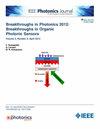基于相位调制的色散移位光纤射频传输分析与论证
IF 2.4
4区 工程技术
Q3 ENGINEERING, ELECTRICAL & ELECTRONIC
引用次数: 0
摘要
本文从理论上分析了基于相位调制(PM-based)的光纤射频传输系统的信号和噪声特性,并对利用色散移位进行射频传输进行了实验验证。推导了传输射频信号的色散相位噪声(DPN)和功率谱密度(PSD)。实验结果表明,对于不同类型的激光器,DPN高度依赖于光载波的相位噪声特性,并且不能仅通过线宽来预测传输系统的短期频率稳定性。在使用不同类型的激光器时,应考虑光载波相位噪声的分布。为了消除色散引起的信号衰落,啁啾光纤布拉格光栅(CFBG)和色散补偿光纤(DCF)分别用于基于pm的射频传输系统。基于cfbg的色散移位方案比基于dcf的方案表现出更强的与温度和光载波线宽相关的时序波动。基于所提出的信号衰落消除方法和有源相位补偿技术,在90 km的单跨光纤链路上传输9ghz射频信号,测得频率稳定度分别达到${\bf 4.8 \ × 10^{-14}}$和${\bf 7.7 \ × 10^{-17}}$。研究结果对微波原子钟的高保真、长单跨和无光放大器光纤传输具有重要的指导意义。本文章由计算机程序翻译,如有差异,请以英文原文为准。
Analysis and Demonstration of Phase Modulation-Based Fiber-Optic Radio Frequency Transfer Using Dispersion Shifting
This paper theoretically analyze signal and noise properties in phase modulation-based (PM-based) fiber-optic radio frequency (RF) transfer system, and experimentally demonstrate RF transfer using dispersion shifting. The dispersion-induced phase noise (DPN) and power spectral density (PSD) of the transferred RF signal are derived. The experimental results indicate that the DPN is highly dependent on phase noise characteristics of optical carrier for different categories of lasers, and the short-term frequency stability of transfer system cannot be predicted solely by linewidth. The distribution of optical carrier phase noise ought to be considered when using different categories of lasers. For eliminating dispersion-induced signal fading, chirped fiber Bragg grating (CFBG) and dispersion compensation fiber (DCF)-based dispersion shifting are employed, respectively, in the PM-based RF transfer system. CFBG-based dispersion shifting scheme exhibits stronger temperature and optical carrier linewidth-related timing fluctuation than DCF-based scheme. Based on the proposed signal fading elimination approach and active phase compensation technique, a 9 GHz RF signal is transferred over a single-span of 90 km fiber link, the measured frequency stabilities reach ${\bf 4.8 \times 10^{-14}}$ ${\bf 7.7 \times 10^{-17}}$
求助全文
通过发布文献求助,成功后即可免费获取论文全文。
去求助
来源期刊

IEEE Photonics Journal
ENGINEERING, ELECTRICAL & ELECTRONIC-OPTICS
CiteScore
4.50
自引率
8.30%
发文量
489
审稿时长
1.4 months
期刊介绍:
Breakthroughs in the generation of light and in its control and utilization have given rise to the field of Photonics, a rapidly expanding area of science and technology with major technological and economic impact. Photonics integrates quantum electronics and optics to accelerate progress in the generation of novel photon sources and in their utilization in emerging applications at the micro and nano scales spanning from the far-infrared/THz to the x-ray region of the electromagnetic spectrum. IEEE Photonics Journal is an online-only journal dedicated to the rapid disclosure of top-quality peer-reviewed research at the forefront of all areas of photonics. Contributions addressing issues ranging from fundamental understanding to emerging technologies and applications are within the scope of the Journal. The Journal includes topics in: Photon sources from far infrared to X-rays, Photonics materials and engineered photonic structures, Integrated optics and optoelectronic, Ultrafast, attosecond, high field and short wavelength photonics, Biophotonics, including DNA photonics, Nanophotonics, Magnetophotonics, Fundamentals of light propagation and interaction; nonlinear effects, Optical data storage, Fiber optics and optical communications devices, systems, and technologies, Micro Opto Electro Mechanical Systems (MOEMS), Microwave photonics, Optical Sensors.
 求助内容:
求助内容: 应助结果提醒方式:
应助结果提醒方式:


